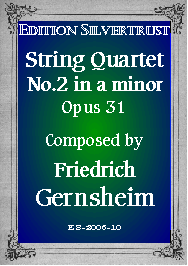Presents
Friedrich Gernsheim
String Quartet No.2 in a minor, Op.31
 Friedrich
Gernsheim (1839-1916) is a composer whose music was held in the highest regard
by critics during his lifetime. No less an authority than Wilhelm Altmann,
perhaps the most important chamber music critic of all time, writes in his
Handbuch für Streichquartettspieler that Gernsheim’s quartets are poetic and
of a high intellectual content. But Gernsheim also had the misfortune to be born
within 6 years of Brahms. A misfortune because, in what is surely an
extraordinary phenomenon, virtually every composer in the German-speaking
countries born within a decade either side of Brahms were so eclipsed by him
that their reputation and music virtually disappeared when that era was over.
Names such as Rheinberger, Reinecke, Kiel, Bruch, Dessoff, and Herzogenberg,
among many others, come to mind.
Friedrich
Gernsheim (1839-1916) is a composer whose music was held in the highest regard
by critics during his lifetime. No less an authority than Wilhelm Altmann,
perhaps the most important chamber music critic of all time, writes in his
Handbuch für Streichquartettspieler that Gernsheim’s quartets are poetic and
of a high intellectual content. But Gernsheim also had the misfortune to be born
within 6 years of Brahms. A misfortune because, in what is surely an
extraordinary phenomenon, virtually every composer in the German-speaking
countries born within a decade either side of Brahms were so eclipsed by him
that their reputation and music virtually disappeared when that era was over.
Names such as Rheinberger, Reinecke, Kiel, Bruch, Dessoff, and Herzogenberg,
among many others, come to mind.
Gernsheim, somewhat of a piano and violin virtuoso as a child, was eventually educated at the famous Leipzig Conservatory where he studied piano with Ignaz Moscheles and violin with Ferdinand David. During the course of his life, he held academic and conducting positions in Cologne, Rotterdam and finally Berlin. He used his position as a conductor to advance the cause of Brahms’ music. The two, while not close friends, carried on a correspondence for many years during which it was clear that Brahms had considerable respect and admiration for Gernsheim’s work. An accolade which was, in Brahms’ case, no mere flattery as Brahms only very rarely praised the works of other composers.
String Quartet No.2 in a, Op.31 was published in 1875. The first movement, Allegro, characterized by its elegiac mood of restless energy, and while the music, in parts, shows the influence of Brahms it nevertheless is fresh sounding. A lovely Adagio follows. The passionate middle section is especially impressive. Next is a muscular and very dramatic scherzo, Molto vivace ed energico, of which the second theme is especially fine. A short, dreamy trio section releases the tension and provides excellent contrast. The rhythmic finale, Allegro moderato e molto energico, seems to begin where the scherzo has left off—it almost seems part of the same movement right down to the introduction of the lovely and lyrical second theme. There is also an ingenious fugal section in the middle of this captivating movement. This is an absolutely first rate work which must be brought back to the concert stage.
Parts: $24.95